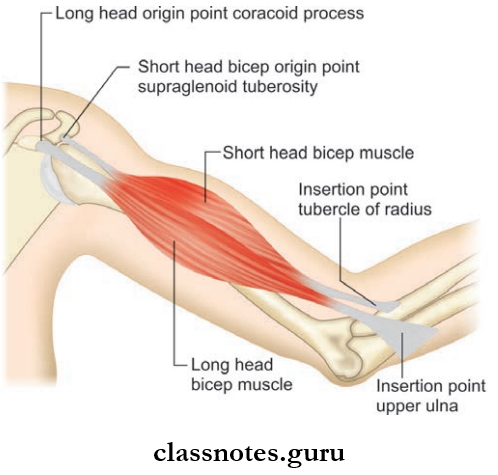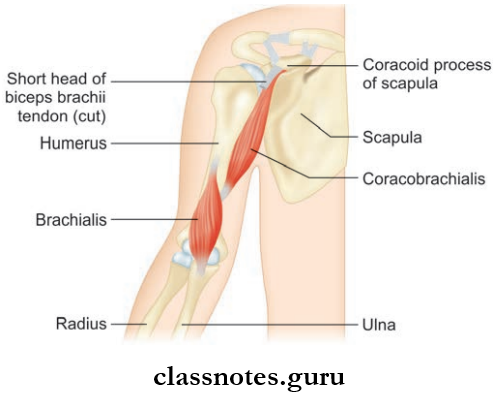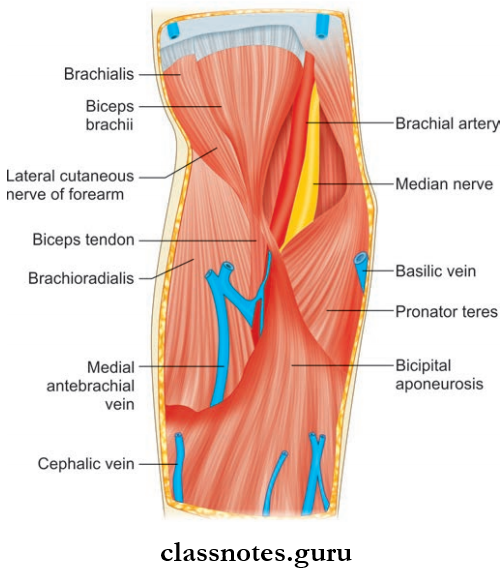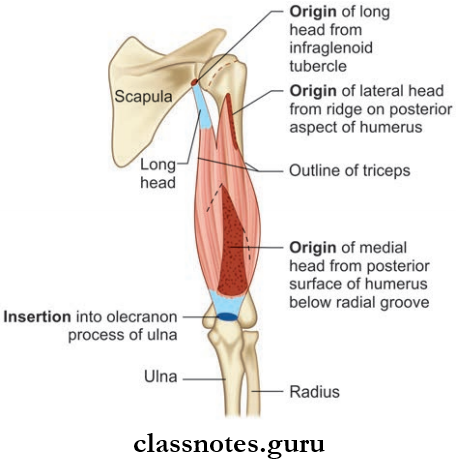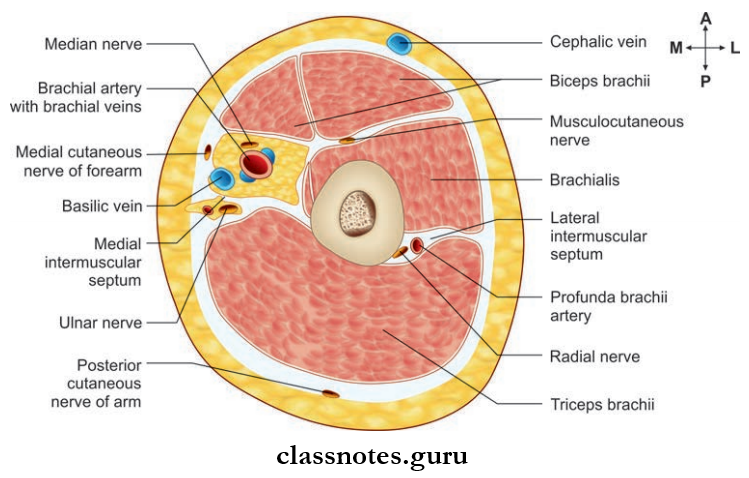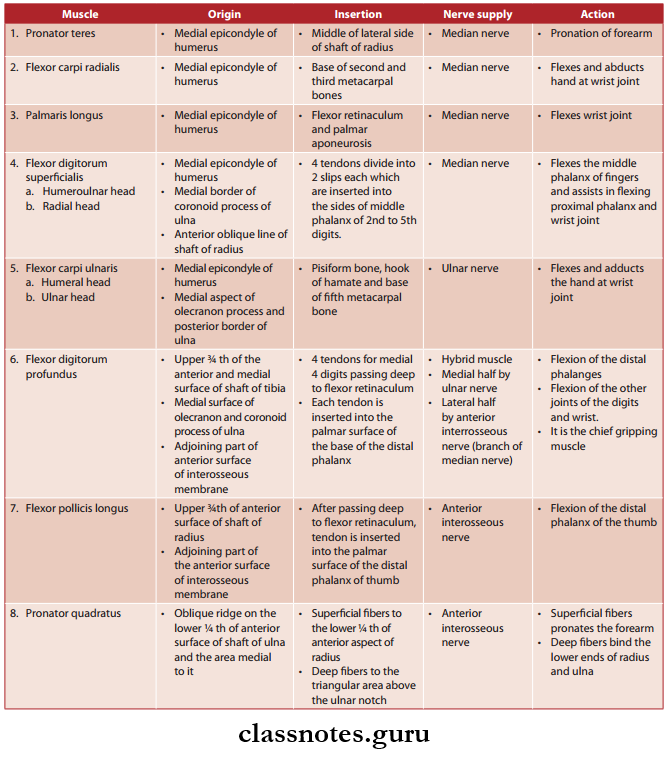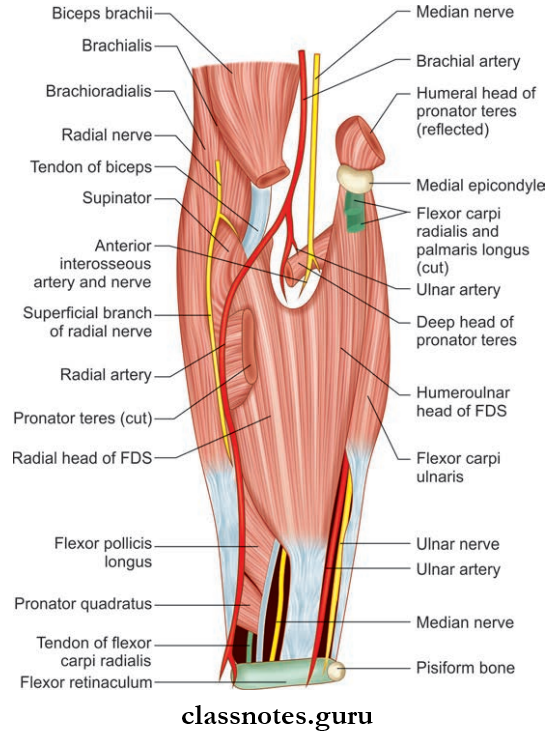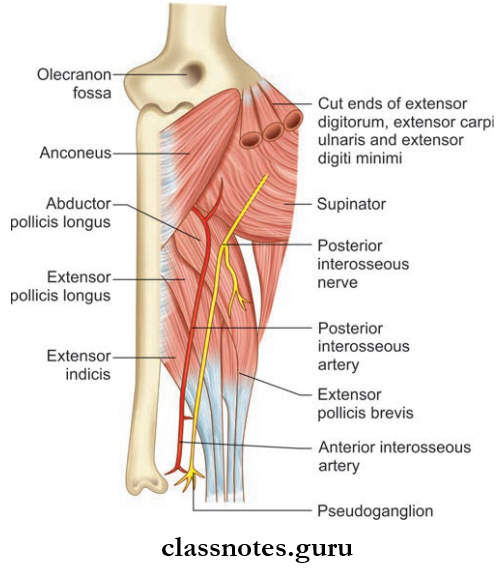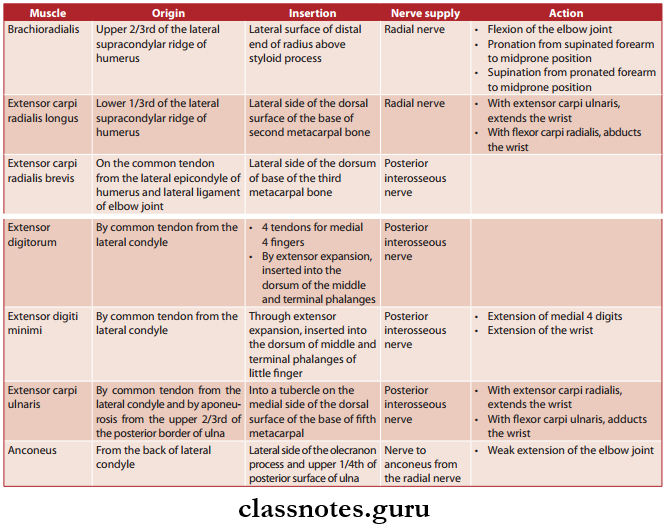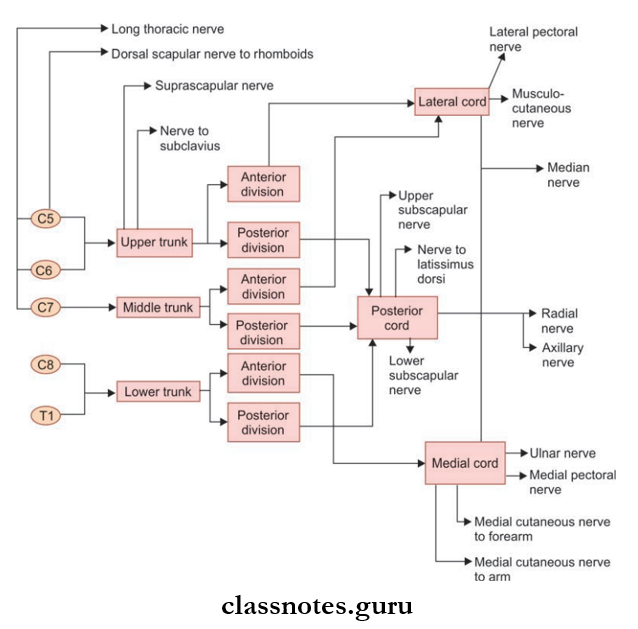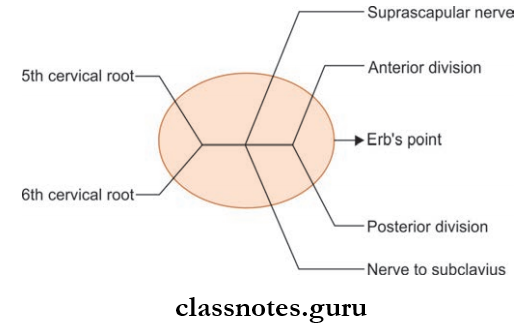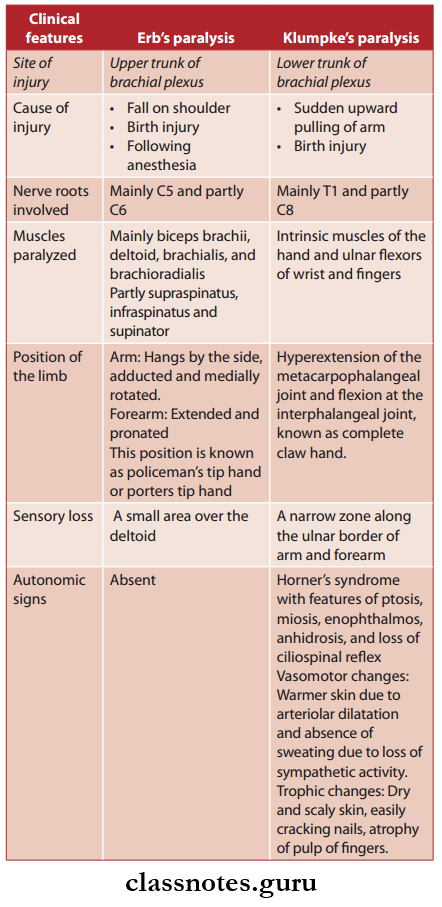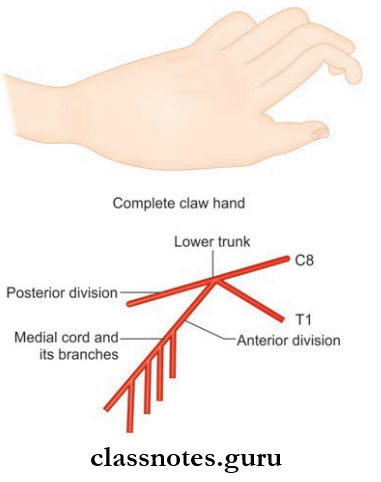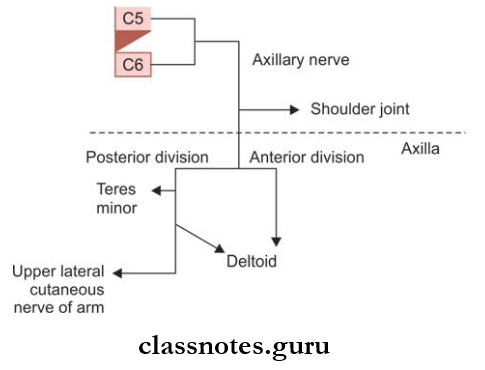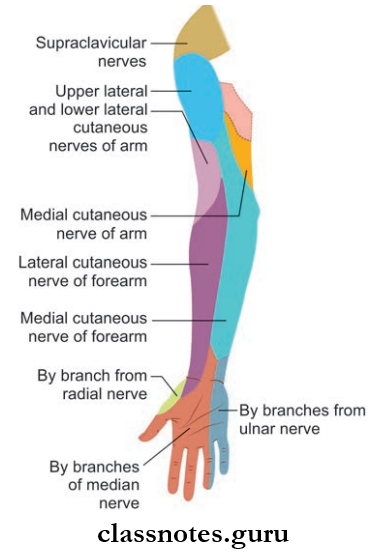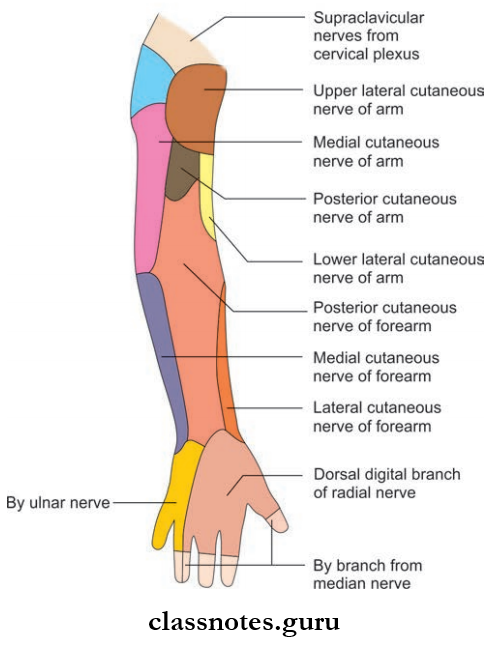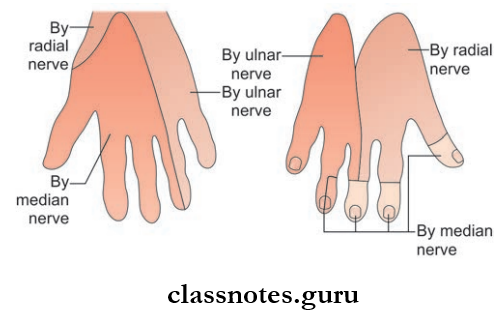Wrist And Hand Introduction
The hand is man’s physical asset.
A large area in the motor cortex of the brain is represented by the hand, indicating the fine and complex movements made by the hand.
Wrist And Hand Question And Answers
Question 1. What are the peculiarities of the skin and superficial fascia of the palmar aspect of the hand? What are the three modifications of the deep fascia in this region?
Answer:
Peculiarities Of Skin
- Peculiarities Of Skin are thick and tough.
- Peculiarities Of Skin are rich in sweat and sebaceous glands.
- The palm creases represent the area of the skin attached to the deep fascia of the hand.
- Skin ridges are provided for gripping, and those seen on the finger pads are called ‘fingerprints’.
Read And Learn More: Upper Limb
Peculiarities of Superfiial Fascia
- Made of dense fibrous bands that bind skin to the deep fascia.
- Contains subcutaneous fat and the Palmaris brevis muscle.
Peculiarities of Deep Fascia
- The deep fascia is modified:
- The wrist forms the flexor retinaculum.
- In the palm to form the palmar aponeurosis.
- The fingers form a fibrous flexor sheath.
Wrist and Hand Anatomy Notes PDF
Question 2. Write a note on the flexor retinaculum.
Answer:
- Flexor Retinaculum is a strong fibrous band formed by the thickening of deep fascia in front of the carpus or anatomical wrist.
- Flexor Retinaculum is rectangular in shape and has four borders and two surfaces.
Flexor retinaculum Attachments
- Medial to:
- Pisiform bone
- Hook of hamate
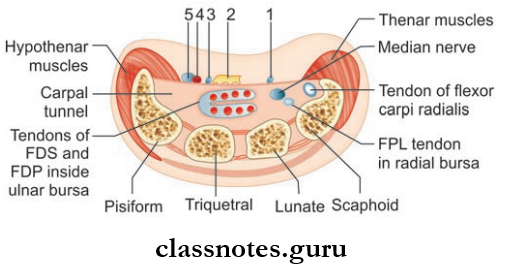
- Palmar cutaneous branch of the median nerve;
- Tendon of palmaris longus;
- Palmar cutaneous branch of the ulnar nerve;
- Ulnar artery;
- Ulnar nerve
- Lateral to:
- Tubercle of scaphoid
- Crest of the trapezium
- On either side, it gives off a slip.
- Lateral Slip:
- Attached to the medial lip of the groove of the trapezium.
- The slip forms an osseofascial tunnel for the passage of the tendon of the flexor carpi radialis.
- Medial Slip:
- Attached to the pisiform bone.
- Ulnar nerve and vessels pass deep to this slip.
Flexor Retinaculum Relations

Flxor Retinaculum Function
- Stabilizes the flexor tendons for smooth action of muscles.
Flexor Retinaculum Clinical Anatomy
- The median nerve can get compressed in the carpal tunnel, also known as carpal tunnel syndrome.
Wrist and Hand Joints Anatomy
Question 3. Write a short note on the palmar aponeurosis.
Answer:
It is a well-defined triangular modification of the deep fascia in the palm.
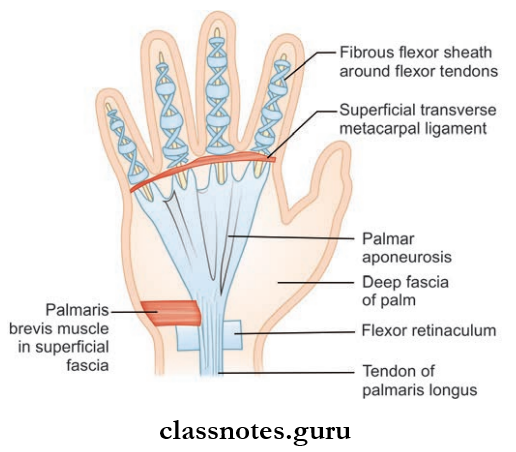
Palmar Aponeurosis Boundaries
- Apex:
- Directed proximally towards the wrist.
- It blends with the flexor retinaculum.
- Base:
- Directed distally towards the root of the figures.
- The base is divided into four longitudinal slips, one each for the medial 4 figures.
- The longitudinal slip again splits into two slips, which blend with the fibrous sheath of corresponding fingers.
- Medial Border:
- It is continuous with the deep fascia covering the hypothenar muscles.
- Lateral Border:
- It is continuous with the deep fascia covering the thenar muscles.
Palmar aponeurosis Functions
- Helps to improve the grip of the hand by fixing the skin.
- Stabilizes and protects the underlying structures.
Question 4. Write a short note on the fibrous flexor sheath of the fingers.
Answer:
Deep fascia lying over the anterior aspect of the digits thickens to form a fibrous flexor sheath.
Firous Flexor Sheath Of Fingers Extend And Attachments
- Proximally: Continuous with palmar aponeurosis.
- Distally: Attached to the distal phalanx. This forms an osteofascial tunnel through which the flexor tendon passes.
Firous Flexor Sheath of the fingers Function
- It holds the flexor tendon during the flexion of the fingers.
Hand Anatomy Viva Questions and Answers
Question 5. What are the three main synovial sheaths of flexor tendons? Describe each of them.
Answer:
There are mainly 3 synovial sheaths that enclose the tendons of the flexor muscles of the hand.
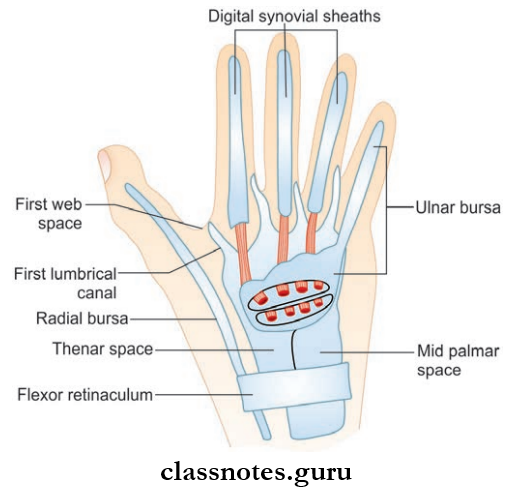
- Common flexor synovial sheath/ulnar bursa
- It encloses the long tendons of both the flexor digitorum superficial and flexor digitorum profundus as they pass through the carpal tunnel.
- It has two layers: the parietal layer lines the walls of the carpal tunnel, and the visceral layer lines the tendons.
- Extend: Upwards up to 5–7 cm into the forearm and downwards into the palm up to the middle of the shaft of the metacarpal bones.
- The lower medial end is continuous with the digital synovial sheath of the little finger.
- Radial bursa
- It encloses the tendons of flxor pollicis longus.
- Extend
- Proximally, It coextends with the ulnar bursa
- Distally: Up to the distal phalanx of the thumb
- It joins with the digital synovial sheath of the thumb.
- Digital synovial sheath
- It encloses the flexor tendons in the fingers and lines the fibrous flexor sheaths.
- The digital synovial sheath of the little finger is continuous with the ulnar bursa, and the digital synovial sheath of the thumb is continuous with the radial bursa.
- But the digital synovial sheaths of the index, middle, and ring fingers are independent.
Functions Of The Synovial Sheath
- By enclosing the tendons, the synovial sheath reduces friction while the muscle acts.
Clinical Anatomy
- Any penetrating injury caused to the digital synovial sheath can result in tenosynovitis.
- Here, the infection causes distension of the sheath by pus and produces pain.
- If the digital synovial sheath of the thumb or little finger is involved, the infection can spread to the radial and ulnar bursa easily due to the continuity.
- It is more dangerous and, if the proximal end of the bursa ruptures, the infection can spread up to the space of the parona. (A fascial space) on the forearm.
Question 6. Classify and list out the intrinsic muscles of the hand. Write about their nerve supply and actions.
Answer:
- Intrinsic Muscles are short muscles having origin and insertion within the hand.
- Intrinsic Muscles are responsible for skilled movement and gripping of the hand.
- Intrinsic Muscles can be classified as:
- Thenar Muscles
- Abductor pollicis brevis
- Flexor pollicis brevis
- Opponents pollicis
- Hypothenar Muscles
- Abductor digiti minimi
- Flexor digiti minimi
- Opponents digit minimi
- Adductors Of Thumb
- Muscle Of The Medial Side Of The Palm
- 4 Lubricants
- Numbered 1–4 from lateral to medial side
- 4 Dorsal And 4 Palmar Interossei
- Numbered 1–4 from lateral to medial side
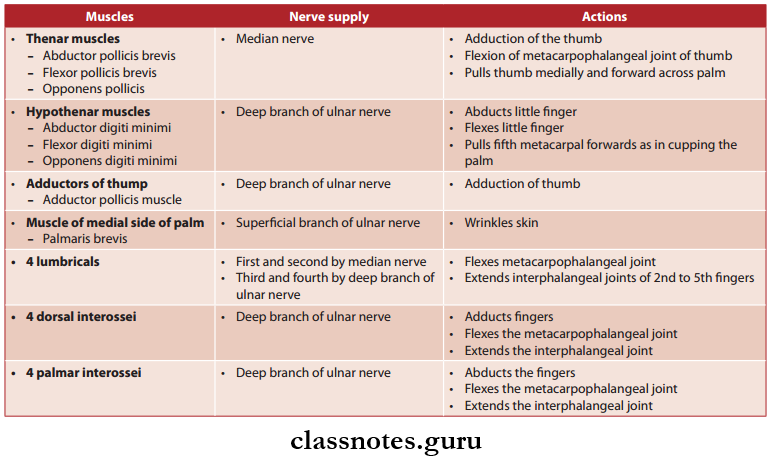
Mnemonics
Interossei Muscles: Actions of dorsal vs Palmar in hand
- PAd And DAb:
- The Palmar Adduct and the Dorsal Abduct
- Use your hand to dab with a pad
- Intrinsic Muscles Of The Hand (Palmar Surface) ‘A OF A OF A’:
- Thenar, lateral to medial:
Anatomy of the Wrist and Hand
Question 7. Briefly explain the spaces of the hand.
Answer:

- Abductor pollicis longus
- Opponents pollicis
- Flexor pollicis brevis
- Adductor pollicis
- Hypothenar, lateral to medial
- Opponents digiti minimi
- Flexor digiti minimi
- Abductor digiti minimi.
- The fascia and fascial septa of the hand divide the hand into several fascial spaces.
- They are potent spaces filled with loose connective tissue, but become obvious when they are infected.
- Knowledge of these spaces is of great surgical importance as these spaces can get infected and filled with pus, causing distention and pain.
- These spaces are:
- Palmar Spaces
- Midpalmar spaces
- Thenar space
- Pulp spaces of fingers
- Dorsal Spaces
- Dorsal subcutaneous space
- Dorsal subaponeurotic space
- The forearm space of the para
Question 8. Write a short note on the mid-palmar space of the hand.
Answer:
Mid-Palmar Space Of the Hand is a triangular-shaped space located under the medial half of the hollow of the palm.
Mid-Palmar Space Of the Hand Boundaries
- Anterior
- From superficial to deep:
- Palmar aponeurosis
- Superfiial palmar arch
- Digital nerve and vessels supplying medial 3-and-a-half fingers
- Ulnar bursa with its tendons
- 2nd, 3rd, 4th lumbricals
- Posterior
- Fascia covering interossei and medial three metacarpals
- Lateral
- Intermediate palmar septum
- Medial
- Proximal
- Midpalmar space is continuous with forearm space of para
- Distal
- Continuous with medial three web spaces through the medial 3 lumbrical canals
Wrist Joint Classification and Structure
Mid-Palmar Space Of the Hand Clinical Anatomy
- The major source of infection in the mid-palmar space is the ulnar bursa.
- When infected, the pus from this space is drained by an incision in the medialmost two web spaces.
Question 9. Write a short note on the thenar space of the hand.
Answer:
Thenar Space Of The Hand is a triangular space located beneath the outer half of the hollow of the palm.
Thenar Space Of The Hand Boundaries
- Anterior
- From superficial to deep, they are:
- Palmar aponeurosis
- Digital nerve and vessels of the lateral 1-and-a-half fingers
- Radial bursa enclosing the tendon of flexor pollicis longus
- Flexor tendons of index figers
- First lumbrical
- Posterior
- Fascia covering the transverse head of adductor pollicis
- Lateral
- Medial
- Intermediate palmar septum
- Proximal
- Only limited space since the anterior and posterior walls fuse in the carpal tunnel
- Distal
- Communicates with the first web space through the first lumbrical canal
Thenar Space Of The Hand Clinical Anatomy
- Infections from the radial bursa or synovial sheath of the index finger can reach the thenar space.
- In such cases, pus is drained by an incision in the first web space.
Question 10. Write a short note on the pulp spaces of your fingers.
Answer:
- They are subcutaneous spaces located on the palmar aspect of the tip of the fingers.
- The pulp space is filled with subcutaneous fatty tissue.
Pulp Spaces Of Figures Boundaries
- Superfiial: Skin and superfiial fascia.
- Deeply: Distal 2/3rd of the distal phalanx.
Pulp Spaces Of Fingers Clinical Anatomy
- It is the most exposed part of the digit and can get easily infected.
- When infected, the abscess formed in the pulp space is called a whitlow.
- The pus from the pulp space is drained by making a lateral incision.
Question 11. Briefly explain the dorsum of the hand.
Answer:
Dorsum Of Hand Skin
- Loose and thin when the hand is relaxed.
Dorsum Of Hand Superficial Fascia
- Contains:
- Dorsal venous arch
- Superficial radial nerve
- Dorsal cutaneous branch of the ulnar nerve.
Dorsum Of Hand Deep Fascia
- Modified to form the extensor retinaculum.

Question 12. Write a note on the extensor retinaculum.
Answer:
- The retinaculum is a strong fibrous band formed by the thickening of deep fascia present in the back of the wrist.
- The retinaculum is directed obliquely downwards and medially.
- The retinaculum is 2 cm wide vertically.
Extensor Retinaculum Attachments
- Medially To:
- Styloid process of the ulna
- Triquetral bone
- Pisiform bone
- Laterally To:
- The lower part of the anterior border of the radius.
- Extensor Retinaculum Compartments
- The retinaculum sends down septa that are attached to the posterior surface of the lower part of the radius.
- Thus, six osseofascial compartments are formed and each compartment is provided with synovial sheaths.
- Structures passing through the compartments from the lateral to the medial side are:
Extensor Retinaculum Functions
- Stabilizes the tendons of extensor muscles for their smooth action.
Question 13. Write a short note on dorsal digital expansion.
Answer:
- They are triangular aponeuroses formed by the expansion of each tendon of the extensor digitorum muscle.
- It covers the dorsum of the metacarpophalangeal joint.
- It fuses anteriorly with a fibrous flexor sheath.
- The tendons of the lumbrical and interossei are inserted into the expansion.
- The expansion narrows as the tendons of the interossei and lumbrical converge towards it on the dorsum of the proximal phalanx.
- From there, it splits into 3 slips.
- The central slip is inserted into the base of the middle phalanx, and the lateral slips to the base of the terminal phalanx.
Muscles of the Wrist and Hand Anatomy
Question 14. What is an anatomical snuff box? What are its boundaries and relations?
Answer:
An anatomical Snuff Box is a triangular depression seen on the lateral side of the dorsum of the hand when the thumb is hyper-extended.
Anatomical Snuff Box Boundaries
- Anterolaterally
- Tendon of the abductor pollicis longus
- Tendon of extensor pollicis brevis
- Posteromedially
- Tendon of extensor pollicis longus
- Floor
- Roof
- Content

Structures Crossing The Roof Under The Skin:
- Cephalic vein
- Terminal branches of the superficial radial nerve
Anatomical Snuff Box Clinical Anatomy
- In a scaphoid bone fracture, tenderness in the anatomical snuff box will be present.
- The cephalic vein can be used to give intravenous fluids at this site.
- Radial artery pulsations can be felt in the anatomical snuff box.
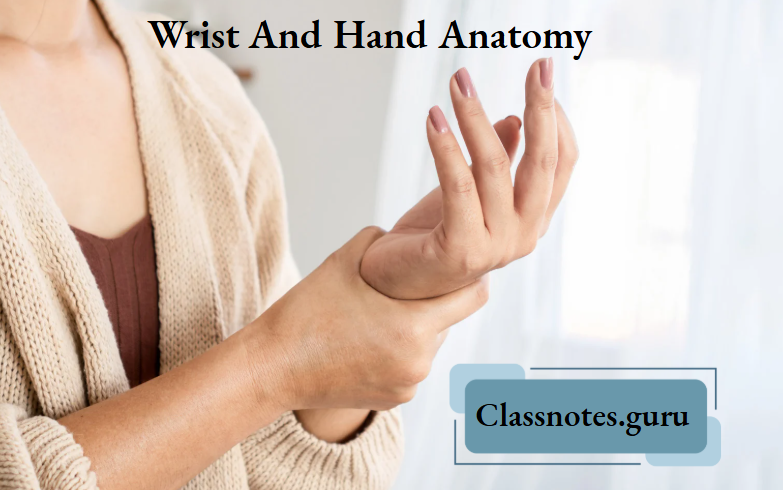
Wrist And Hand Multiple Choice Questions
Question 1. Froment’s test is done to check the integrity of the:
- Second palmar interosseous
- Second dorsal interosseous
- Adductor pollicis
- First lumbrical
Answer: 3. Adductor pollicis
Question 2. Which of the following is not a modification of the deep fascia?
- Extensor retinaculum
- Palmar aponeurosis
- Extensor expansion
- Fibrous flexor sheath
Answer: 3. Fibrous flexor sheath
Question 3. Hammer thumb deformity is due to the rupture of the tendon of
- Flexor pollicis longus
- Abductor pollicis longus
- Extensor pollicis brevis
- Extensor pollicis longus
Answer: 4. Extensor pollicis longus
Anatomy of Hand and Wrist – Medical Students Guide
Question 4. Adduction of the middle finger is brought about by:
- Third dorsal interosseous
- Third lubricants
- Second and third dorsal interossei
- Second and third lubricants
Answer: 3. Second and third dorsal interossei
Question 5. What are the four chief bony attachments of the flexor retinaculum?
- Hamate, pisiform, trapezium, scaphoid
- Hamate, capitate, trapezoid, scaphoid
- Lunate, hamate, capitate, scaphoid
- Lunate, pisiform, trapezoid, hamate
- Trapezium, trapezoid, capitate, hamate
Answer: 1. Hamate, pisiform, trapezium, scaphoid
